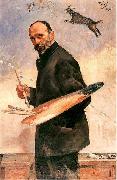|
||||||||||
|
|
||||||||||
|
Hunters' rest in forest ID de tableau:: 74576 Voir la galerie dans Suède |
Hunters' rest in forest 1889;. oil on canvas, 58 x 119 cm. cjr 1889;. oil_on_canvas,_58_x_119_cm. cjr |
|||||||||
|
|
||||||||||
|
Elk ID de tableau:: 74590 Voir la galerie dans Suède |
Elk oil on canvas, 96 x 192 cm. 1899 cjr oil_on_canvas,_96_x_192_cm. 1899 cjr |
|||||||||
|
|
||||||||||
|
Self-portrait from palette ID de tableau:: 74591 Voir la galerie dans Suède |
Self-portrait from palette Oil on canvas, 135,5 x 86 cm. 1896 cjr Oil_on_canvas,_135,5_x_86_cm. 1896 cjr |
|||||||||
|
|
||||||||||
|
Self-portrait. ID de tableau:: 86037 Voir la galerie dans Suède |
Self-portrait. Date 1903 Medium Oil on canvas Dimensions 47.5 x 132.5 cm (18.7 x 52.2 in) cjr Date_1903 _ Medium_Oil_on_canvas _ Dimensions_47.5_x_132.5_cm_(18.7_x_52.2_in) _ cjr |
|||||||||
|
|
||||||||||
|
Self portrait ID de tableau:: 97878 Voir la galerie dans Suède |
Self portrait 1903 Medium oil on canvas Dimensions 47.5 x 132.5 cm cyf 1903_ Medium_oil_on_canvas_ Dimensions_47.5_x_132.5_cm_ cyf |
|||||||||
|
|
||||||||||
| Artiste précédent Artiste prochain | ||||||||||
|
|
||||||||||
| Julian Falat | ||||||||||
| (30 July 1853 in Tuligłowy near Lwew - 9 July 1929 in Bystra Śląska) was one of the most prolific Polish painters of watercolor and one of the country's foremost landscape painters as well as one of the leading Polish impressionists. Fałat first studied under Władysław Łuszczkiewicz at the Krakew School of Fine Arts, and then at the Art Academy of Munich. After several trips throughout Europe and Asia in 1885, Fałat compiled a collection of studies from his voyages which would become useful later in the development of his artwork. Themes typical of Fałat's painting are Polish landscapes, hunting scenes, portraits, and studies from his voyages. In 1886, Fałat accepted an invitation from future German Emperor Wilhelm II to serve as court painter in Berlin. Fałat died in Bystra Śląska on July 9, 1929. A museum in Poland, called Fałatewka, is devoted to him. Out of his three children, Kazimierz (Togo) (1904-1981) continued to paint in watercolour. Some works, having been looted under German occupation, very occasionally reappear in sales-rooms. Later works, produced after he settled in England, are largely in the hands of his later family. | ||||||||||
|
|
||||||||||
IntoFineArt Co,.Ltd.














